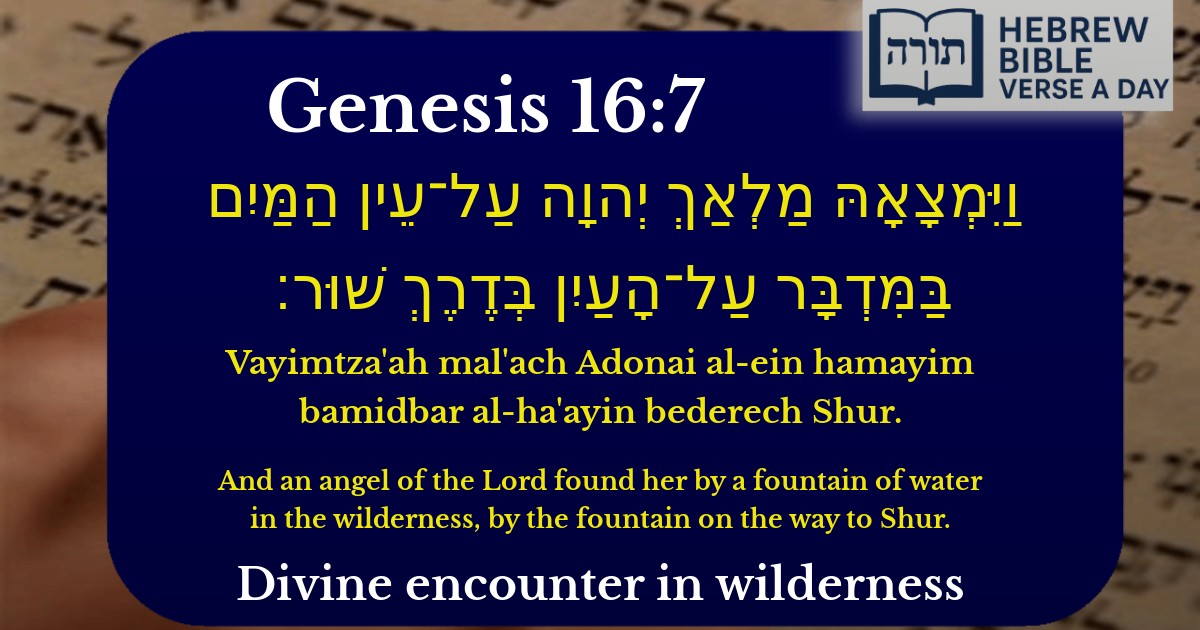Join Our Newsletter To Be Informed When New Videos Are Posted
Join the thousands of fellow Studends who rely on our videos to learn how to read the bible in Hebrew for free!
Hebrew Text
וַיִּמְצָאָהּ מַלְאַךְ יְהוָה עַל־עֵין הַמַּיִם בַּמִּדְבָּר עַל־הָעַיִן בְּדֶרֶךְ שׁוּר׃
English Translation
And an angel of the Lord found her by a fountain of water in the wilderness, by the fountain on the way to Shur.
Transliteration
Vayimtza'ah mal'ach Adonai al-ein hamayim bamidbar al-ha'ayin bederech Shur.
Hebrew Leining Text
וַֽיִּמְצָאָ֞הּ מַלְאַ֧ךְ יְהֹוָ֛ה עַל־עֵ֥ין הַמַּ֖יִם בַּמִּדְבָּ֑ר עַל־הָעַ֖יִן בְּדֶ֥רֶךְ שֽׁוּר׃
וַֽיִּמְצָאָ֞הּ מַלְאַ֧ךְ יְהֹוָ֛ה עַל־עֵ֥ין הַמַּ֖יִם בַּמִּדְבָּ֑ר עַל־הָעַ֖יִן בְּדֶ֥רֶךְ שֽׁוּר׃
🎵 Listen to leining
Parasha Commentary
📚 Talmud Citations
This verse is quoted in the Talmud.
📖 Rosh Hashanah 16b
The verse is referenced in a discussion about divine providence and the ways in which God intervenes in the lives of individuals, particularly in times of distress.
📖 Sanhedrin 95b
The verse is mentioned in the context of discussing the merits of Hagar and how divine intervention played a role in her life.


Context of the Verse
This verse (Bereshit 16:7) describes the encounter between Hagar, Sarai's maidservant, and an angel of Hashem after she fled from Sarai's household. The verse appears in the narrative of Hagar's pregnancy with Yishmael and the subsequent tensions between her and Sarai.
Rashi's Commentary
Rashi explains that the angel found Hagar "by a fountain of water in the wilderness" because this location was along the road to Egypt, her homeland. He notes that the phrase "on the way to Shur" refers to the path leading back to Egypt, as Shur was near the Egyptian border (Rashi on Bereshit 16:7, citing Bereshit 25:18). Rashi also emphasizes that the angel's appearance was an act of divine compassion, as Hagar was in distress.
Ramban's Insight
The Ramban (Nachmanides) adds that the repetition of "by a fountain of water" and "by the fountain" suggests that this was a well-known place, perhaps a stopping point for travelers. He interprets the angel's appearance as a sign of divine providence, ensuring that Hagar would not perish in the wilderness (Ramban on Bereshit 16:7).
Midrashic Interpretation
The Midrash (Bereshit Rabbah 45:6) elaborates that the angel found Hagar near the same well where future encounters between the Jewish people and divine messengers would occur, hinting at a deeper spiritual significance to the location. This well is later associated with the well of Miriam in the wilderness.
Symbolism of the Wilderness
Halachic and Ethical Lessons
The Malbim highlights that the angel's approach teaches the importance of compassion toward those in distress, even if they have erred. Hagar, though she had acted disrespectfully toward Sarai (Bereshit 16:4), was still deserving of divine mercy. This aligns with the Torah's broader ethic of caring for the vulnerable, including strangers and servants.